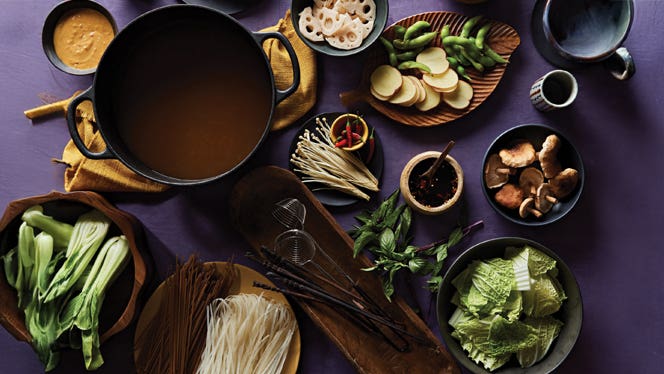
A Beginner’s Guide to Vietnamese Hot Pot
Hot pot, a beloved culinary tradition originating in China and celebrated across East and Southeast Asia, is more than just a meal—it’s an experience. Diners gather around a large pot of flavorful broth set on a portable burner. As the broth simmers, everyone adds vegetables, noodles, and other ingredients to the pot, creating a feast that’s as much about connection as it is about taste. This communal dining ritual is especially cherished during cooler months or festive occasions like Lunar New Year. In Vietnam, hot pot is called lâu. Broths come in a variety of flavors, such as spicy, fermented bean curd, or sweet and sour, which is known in Vietnamese as lâu chua ngot.
Ready to try your hand at creating a Vietnamese-style hot pot? Here’s a step-by-step guide to hosting your own lẩu feast for four people, complete with easy recipes for a flavorful broth and dipping sauces, a list of vibrant add-ins, and more tips savoring this timeless dining tradition.
How to Make Vietnamese Hot Pot
1. Prepare the broth and dipping sauces: Follow our simple, flavorful recipes for Sweet and Sour Hot Pot Broth, Peanut Sesame Dipping Sauce, and Garlic Dipping Sauce.
2. To set the table for the hot pot experience, start by placing a large pot filled with the prepared broth in the center of the table on a portable burner or hot plate. (You can also use a rice cooker.) Arrange platters or bowls of prepped vegetables and other add-ins (see suggestions below) around the pot. Don’t forget two big spoons (one with holes, one without) for scooping out the ingredients and broth.
3. Each place setting should include a bowl, chopsticks, soup spoon, and two small bowls of dipping sauces. Additional plates can be provided for holding cooked ingredients.
4. Each person at the table chooses a handful of ingredients to add to the pot. Once added, cover the pot and simmer until the add-ins are cooked. (If using a rice cooker, switch to the Cook function and close the lid.) Keep in mind that different vegetables will require different cooking times: Greens and tofu take about 5 minutes to cook, while mushrooms and potatoes might take 10 minutes. Tip: The smaller an ingredient is chopped, the faster it will cook.
5. When add-ins are cooked through, someone (usually the chef) uses a slotted spoon or spider skimmer to transfer them to a clean plate. Diners then take some of the food to their own bowls to enjoy with dipping sauces. Diners can also ladle some broth from the hot pot into their bowls to accompany noodles.
6. More fresh ingredients are then added to the simmering pot, and the process is repeated until all the add-ins run out or everyone is full. When the broth starts to run low, you can add more water as needed.
All About Add-Ins
The add-ins—the ingredients you add to the pot to cook in the broth—are central to the hot pot experience. Feel free to get creative with your add-ins, but here are some suggestions to guide you.
Leafy Greens (Pick 1–2)
- 8 baby bok choy, trimmed and leaves separated
- 8 oz. Asian leafy greens, such as choi sum or Chinese water spinach, sliced
- 1 head napa cabbage, leaves separated and chopped into bite-size pieces
Root Veggies (Pick 1–2)
- 2 carrots, peeled and thinly sliced
- 1 lotus root, soaked in cold water 10 minutes then sliced into ¼ -inch-thick half-moons
- 3 potatoes, peeled and thinly sliced
- 1 taro root, peeled and thinly sliced
Mushrooms (2–2½ cups)
Aim for at least three fresh mushroom varieties, such as shiitake, king oyster, shimeji, wood ear, or enoki.
Proteins & Noodles (Pick 2–3)
- 1 lb. firm or extra-firm tofu, cut into cubes
- 1 sheet tofu skin
- 7 oz. fresh or frozen shelled edamame
- 6 oz. dry brown rice noodles, such as mai fun or pad Thai
- 6 oz. dry soba (buckwheat) noodles
Do’s and Don’ts
DO wait for the broth to start boiling before adding new ingredients.
DON’T dip your chopsticks and spoons directly into the shared pot. Instead, use the big spoons or dedicated chopsticks to scoop out ingredients.
DO take your time when eating and adding ingredients to the pot. Hot pot is meant to be a leisurely, communal experience.
To learn more about a whole-food, plant-based diet, visit our Plant-Based Primer. For meal-planning support, check out Forks Meal Planner, FOK’s easy weekly meal-planning tool to keep you on a healthy plant-based path.
About the Author

About the Author
Anh Tran
Join our mailing list
Get free recipes and the latest info on living a happy, healthy plant-based lifestyle.
By providing your email address, you consent to receive newsletter emails from Forks Over Knives. We value your privacy and will keep your email address safe. You may unsubscribe from our emails at any time.
